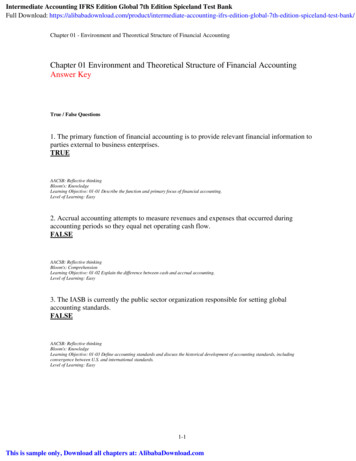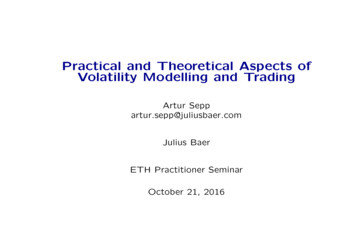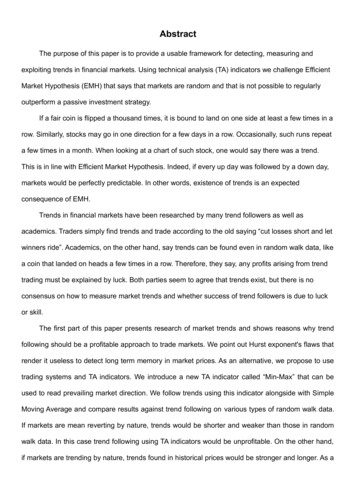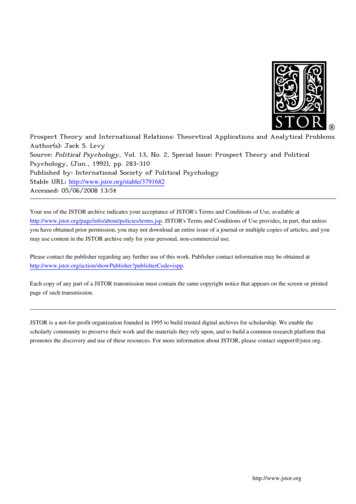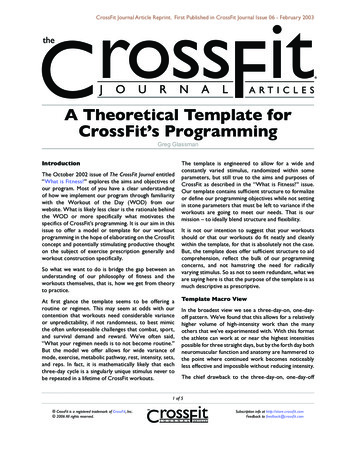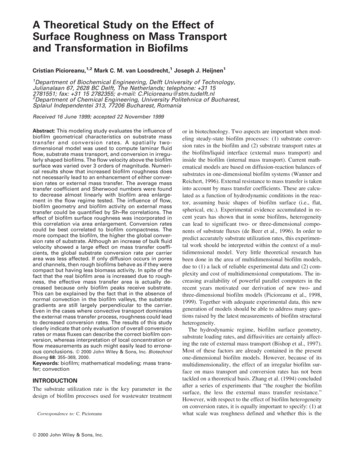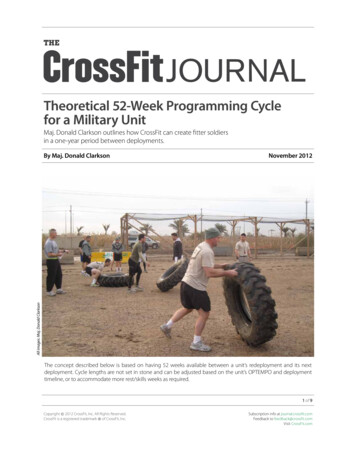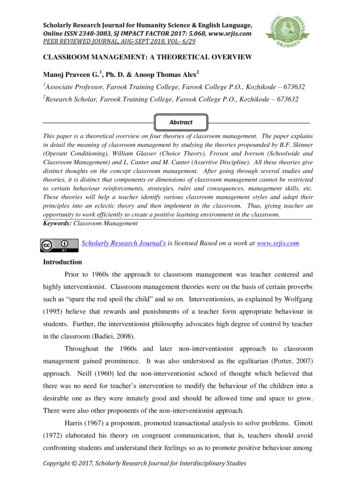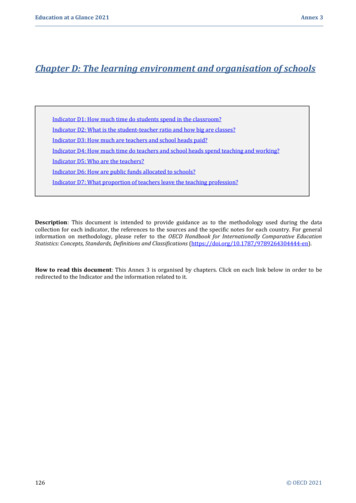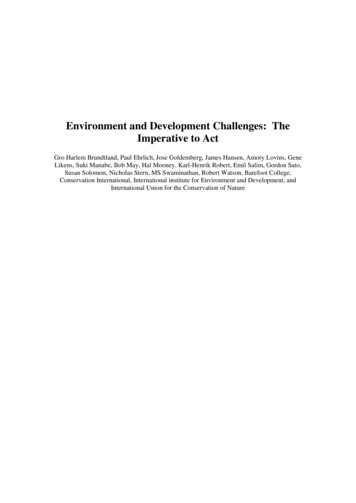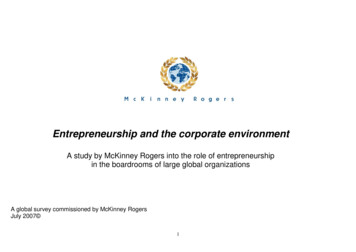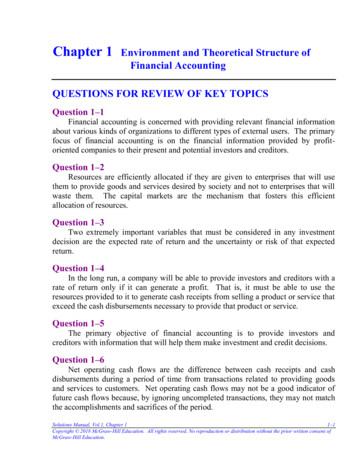
Transcription
Chapter 1Environment and Theoretical Structure ofFinancial AccountingQUESTIONS FOR REVIEW OF KEY TOPICSQuestion 1–1Financial accounting is concerned with providing relevant financial informationabout various kinds of organizations to different types of external users. The primaryfocus of financial accounting is on the financial information provided by profitoriented companies to their present and potential investors and creditors.Question 1–2Resources are efficiently allocated if they are given to enterprises that will usethem to provide goods and services desired by society and not to enterprises that willwaste them. The capital markets are the mechanism that fosters this efficientallocation of resources.Question 1–3Two extremely important variables that must be considered in any investmentdecision are the expected rate of return and the uncertainty or risk of that expectedreturn.Question 1–4In the long run, a company will be able to provide investors and creditors with arate of return only if it can generate a profit. That is, it must be able to use theresources provided to it to generate cash receipts from selling a product or service thatexceed the cash disbursements necessary to provide that product or service.Question 1–5The primary objective of financial accounting is to provide investors andcreditors with information that will help them make investment and credit decisions.Question 1–6Net operating cash flows are the difference between cash receipts and cashdisbursements during a period of time from transactions related to providing goodsand services to customers. Net operating cash flows may not be a good indicator offuture cash flows because, by ignoring uncompleted transactions, they may not matchthe accomplishments and sacrifices of the period.Solutions Manual, Vol.1, Chapter 11–1Copyright 2018 McGraw-Hill Education. All rights reserved. No reproduction or distribution without the prior written consent ofMcGraw-Hill Education.
Answers to Questions (continued)Question 1–7GAAP (generally accepted accounting principles) are a dynamic set of bothbroad and specific guidelines that a company should follow in measuring andreporting the information in their financial statements and related notes. It isimportant that all companies follow GAAP so that investors can compare financialinformation across companies to make their resource allocation decisions.Question 1–8In 1934, Congress created the SEC and gave it the job of setting accounting andreporting standards for companies whose securities are publicly traded. The SEC hasretained the power, but has relied on private sector bodies to create the standards. Thecurrent private sector body responsible for setting accounting standards is the FASB.Question 1–9Auditors are independent, professional accountants who examine financialstatements to express an opinion. The opinion reflects the auditors’ assessment of thestatements' fairness, which is determined by the extent to which they are prepared incompliance with GAAP. The auditor adds credibility to the financial statements,which increases the confidence of capital market participants relying on thatinformation.1–2Intermediate Accounting, 9eCopyright 2018 McGraw-Hill Education. All rights reserved. No reproduction or distribution without the prior written consent ofMcGraw-Hill Education.
Answers to Questions (continued)Question 1–10On July 30, 2002, President Bush signed into law the Sarbanes-Oxley Act of2002. The most dramatic change to federal securities laws since the 1930s, the Actradically redesigns federal regulation of public company corporate governance andreporting obligations. It also significantly tightens accountability standards fordirectors and officers, auditors, securities analysts, and legal counsel. Student opinionsas to the relative importance of the key provisions of the act will vary. Key provisionsin the order of presentation in the text are: Creation of an Oversight Board Corporate executive accountability Nonaudit services Retention of work papers Auditor rotation Conflicts of interest Hiring of auditor Internal controlQuestion 1–11New accounting standards, or changes in standards, can have significantdifferential effects on companies, investors and creditors, and other interest groups bycausing redistribution of wealth. There also is the possibility that standards couldharm the economy as a whole by causing companies to change their behavior.Question 1–12The FASB undertakes a series of elaborate information gathering steps beforeissuing an accounting standard to determine consensus as to the preferred method ofaccounting, as well as to anticipate adverse economic consequences.Question 1–13The purpose of the conceptual framework is to guide the Board in developingaccounting standards by providing an underlying foundation and basic reasoning onwhich to consider merits of alternatives. The framework does not prescribe GAAP.Solutions Manual, Vol.1, Chapter 11–3Copyright 2018 McGraw-Hill Education. All rights reserved. No reproduction or distribution without the prior written consent ofMcGraw-Hill Education.
Answers to Questions (continued)Question 1–14Relevance and faithful representation are the primary qualitative characteristicsthat make information decision-useful. Relevant information will possess predictiveand/or confirmatory value. Faithful representation is the extent to which there isagreement between a measure or description and the phenomenon it purports torepresent.Question 1–15The components of relevant information are predictive value, confirmatory valueand materiality. The components of faithful representation are completeness,neutrality, and freedom from error.Question 1–16The benefit from providing accounting information is increased decisionusefulness. If the information is relevant and possesses faithful representation, it willimprove the decisions made by investors and creditors. However, there are costs toproviding information that include costs to gather, process, and disseminate thatinformation. There also are costs to users in interpreting the information as well aspossible adverse economic consequences that could result from disclosinginformation. Information should not be provided unless the benefits exceed the costs.Question 1–17Information is material if it is deemed to have an effect on a decision made by auser. The threshold for materiality will depend principally on the relative dollaramount of the transaction being considered. One consequence of materiality is thatGAAP need not be followed in measuring and reporting a transaction if thattransaction is not material. The threshold for materiality has been left to subjectivejudgment.1–4Intermediate Accounting, 9eCopyright 2018 McGraw-Hill Education. All rights reserved. No reproduction or distribution without the prior written consent ofMcGraw-Hill Education.
Answers to Questions (continued)Question 1–181.Assets are probable future economic benefits obtained or controlled by aparticular entity as a result of past transactions or events.2. Liabilities are probable future sacrifices of economic benefits arising frompresent obligations of a particular entity to transfer assets or provide services toother entities in the future as a result of past transactions.3. Equity is the residual interest in the assets of any entity that remains afterdeducting its liabilities.4. Investments by owners are increases in equity resulting from transfers ofresources, usually cash, to a company in exchange for ownership interest.5. Distributions to owners are decreases in equity resulting from transfers to owners.6. Revenues are inflows of assets or settlements of liabilities from delivering orproducing goods, rendering services, or other activities that constitute the entity’songoing major or central operations.7. Expenses are outflows or other using up of assets or incurrences of liabilitiesduring a period from delivering or producing goods, rendering services, or otheractivities that constitute the entity’s ongoing major or central operations.8. Gains are defined as increases in equity from peripheral or incidental transactionsof an entity.9. Losses represent decreases in equity arising from peripheral or incidentaltransactions of an entity.10. Comprehensive income is defined as the change in equity of an entity during aperiod from nonowner transactions.Question 1–19The four basic assumptions underlying GAAP are (1) the economic entityassumption, (2) the going concern assumption, (3) the periodicity assumption, and (4)the monetary unit assumption.Question 1–20The going concern assumption means that, in the absence of information to thecontrary, it is anticipated that a business entity will continue to operate indefinitely.This assumption is important to many broad and specific accounting principles suchas the historical cost principle.Solutions Manual, Vol.1, Chapter 11–5Copyright 2018 McGraw-Hill Education. All rights reserved. No reproduction or distribution without the prior written consent ofMcGraw-Hill Education.
Answers to Questions (continued)Question 1–21The periodicity assumption relates to needs of external users to receive timelyfinancial information. This assumption requires that the economic life of a companybe divided into artificial periods for financial reporting. Companies usually report toexternal users at least once a year.Question 1–22Four accounting practices, often referred to as principles, that guide accountingpractice are (1) revenue recognition, (2) expense recognition, (3) mixed-attributemeasurement (including historical cost), and (4) full disclosure.Question 1–23Two advantages to basing valuation on historical cost are (1) historical costprovides important cash flow information since it represents the cash or cashequivalent paid for an asset or received in exchange for the assumption of a liability,and (2) historical cost valuation is the result of an exchange transaction between twoindependent parties and the agreed upon exchange value is, therefore, objective andpossesses a high degree of verifiability.Question 1–24Companies recognize revenue when goods or services are transferred tocustomers. However, no revenue is recognized if it isn’t probable that the seller willcollect the amounts it’s entitled to receive. The amount of revenue recognized is theamount the company expects to be entitled to receive in exchange for those goods orservices. Revenue is recognized at a point in time or over a period of time, dependingon when goods or services are transferred to customers. So, revenue for the sale ofmost goods is recognized upon delivery, but revenue for services like rentingapartments or lending money is recognized over time as those services are provided.1–6Intermediate Accounting, 9eCopyright 2018 McGraw-Hill Education. All rights reserved. No reproduction or distribution without the prior written consent ofMcGraw-Hill Education.
Answers to Questions (continued)Question 1–25The four different approaches to implementing expense recognition are:1. Recognizing an expense based on an exact cause-and-effect relationshipbetween a revenue and expense event. Cost of goods sold is an example of anexpense recognized by this approach.2. Recognizing an expense by identifying the expense with the revenuesrecognized in a specific time period. Office salaries are an example of anexpense recognized by this approach.3. Recognizing an expense by a systematic and rational allocation to specifictime periods. Depreciation is an example of an expense recognized by thisapproach.4. Recognizing expenses in the period incurred, without regard to relatedrevenues. Advertising is an example of an expense recognized by thisapproach.Question 1–26In addition to the financial statement elements arrayed in the basic financialstatements, information is disclosed by means of parenthetical or modifyingcomments, notes, and supplemental schedules and tables.Question 1–27GAAP prioritizes the inputs companies should use when determining fair value.The highest and most desirable inputs, Level 1, are quoted market prices in activemarkets for identical assets or liabilities. Level 2 inputs are other than quoted pricesthat are observable, including quoted prices for similar assets or liabilities in active orinactive markets and inputs that are derived principally from observable relatedmarket data. Level 3 inputs, the least desirable, are inputs that reflect the entity’s ownassumptions about the assumptions market participants would use in pricing the assetor liability based on the best information available in the circumstances.Question 1–28Common measurement attributes are historical cost, net realizable value, currentcost, present value, and fair value.Solutions Manual, Vol.1, Chapter 11–7Copyright 2018 McGraw-Hill Education. All rights reserved. No reproduction or distribution without the prior written consent ofMcGraw-Hill Education.
Answers to Questions (concluded)Question 1–29Under the revenue/expense approach, revenues and expenses are consideredprimary, and assets, liabilities, and equities are secondary in the sense of beingrecognized at the time and amount necessary to achieve proper revenue and expenserecognition. Under the asset/liability approach, assets and liabilities are consideredprimary, and revenues and expenses are secondary in the sense of being recognized atthe time and amount necessary to allow recognition and measurement of assets andliabilities as required by their definitions.Question 1–30Under IFRS, the conceptual framework provides guidance to accounting standardsetters but also provides GAAP when more specific accounting standards do notprovide guidance.Question 1–31The International Accounting Standards Board (IASB) is responsible fordetermining IFRS. The IASB is funded by the IFRS Foundation. .Question 1–32The SEC staff’s Final Staff Report concludes that it is not feasible fo
Financial accounting is concerned with providing relevant financial information about various kinds of organizations to different types of external users. The primary focus of financial accounting is on the financial information provided by profit- oriented companies to their present and potential investors and creditors. Question 1–2 Resources are efficiently allocated if they are given to .
